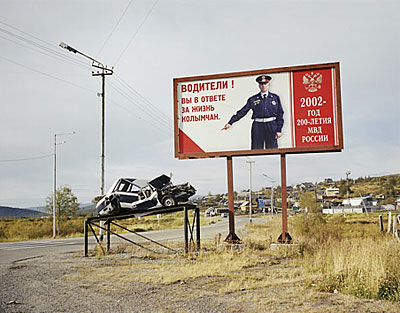|
| |
Archives
peace

A great writer is gone. At least he was great for me. If you haven't, read him. Then his voice will still be heard.
Kurt Vonnegut, Writer of Classics of the American Counterculture, Dies at 84
|
Kurt Vonnegut, whose dark comic talent and urgent moral vision in novels like “Slaughterhouse-Five,” “Cat’s Cradle” and “God Bless You, Mr. Rosewater” caught the temper of his times and the imagination of a generation, died Wednesday night in Manhattan. He was 84 and had homes in Manhattan and in Sagaponack on Long Island.
His death was reported by Morgan Entrekin, a longtime family friend, who said Mr. Vonnegut suffered brain injuries as a result of a fall several weeks ago.
Mr. Vonnegut wrote plays, essays and short fiction. But it was his novels that became classics of the American counterculture, making him a literary idol, particularly to students in the 1960s and ’70s. Dog-eared paperback copies of his books could be found in the back pockets of blue jeans and in dorm rooms on campuses throughout the United States.
Like Mark Twain, Mr. Vonnegut used humor to tackle the basic questions of human existence: Why are we in this world? Is there a presiding figure to make sense of all this, a god who in the end, despite making people suffer, wishes them well?
He also shared with Twain a profound pessimism. “Mark Twain,” Mr. Vonnegut wrote in his 1991 book, “Fates Worse Than Death: An Autobiographical Collage,” “finally stopped laughing at his own agony and that of those around him. He denounced life on this planet as a crock. He died.”
Not all Mr. Vonnegut’s themes were metaphysical. With a blend of vernacular writing, science fiction, jokes and philosophy, he also wrote about the banalities of consumer culture, for example, or the destruction of the environment.
His novels — 14 in all — were alternate universes, filled with topsy-turvy images and populated by races of his own creation, like the Tralfamadorians and the Mercurian Harmoniums. He invented phenomena like chrono-synclastic infundibula (places in the universe where all truths fit neatly together) as well as religions, like the Church of God the Utterly Indifferent and Bokononism (based on the books of a black British Episcopalian from Tobago “filled with bittersweet lies,” a narrator says).
The defining moment of Mr. Vonnegut’s life was the firebombing of Dresden, Germany, by Allied forces in 1945, an event he witnessed firsthand as a young prisoner of war. Thousands of civilians were killed in the raids, many of them burned to death or asphyxiated. “The firebombing of Dresden,” Mr. Vonnegut wrote, “was a work of art.” It was, he added, “a tower of smoke and flame to commemorate the rage and heartbreak of so many who had had their lives warped or ruined by the indescribable greed and vanity and cruelty of Germany.”
| |
[more]
give us this day our daily photograph

Apple Store
bigger
gordy's image archive index
image overload
Right now I'm into image overload. I've been working on sorting through the pictures Zoe and I took of Robyn's (our granddaughter) visit.

And there she is making one of the hardest choices an 8 year old has to make: which flavor of ice cream? I started with over 840 photos and have it rough cut to 323. Candi and Katie took a few but most were taken by Zoe and your humble servant. There are still a few I need to get from Robby, which should be here today. Then it's preparing them all for the website.

In one of my very first posts in this blog I offered to post pictures of how I made bread. That was August, 2000. (My, what a different world it was then!) I've been making bread for the past 35 years and I've passed the recipe off to people before and they haven't had success making it so I thought a detailed set of pictures would help. Zoe did most of the shooting and now I have 267 photos to edit into a website on making Gordy Bread™.

Yesterday evening my son Robby, and his partner Hannah, picked me up and we went up to Oak Harbor to look at a scooter.

It's a cute little thing, a 50cc Yamaha. It belongs to Zoe's hairdresser who moved up to a customized Harley Sportster. Robby's VW van is close to being terminal and he was looking for cheap transportation for getting to work. The little Yamaha only has a top speed of 35mph but that's not a problem on the back roads of Whidbey Island.

It was easy to lift up into the back of a pickup truck and we were on our way.
easter
Computus
|
Computus (Latin for computation) is the calculation of the date of Easter in the Christian calendar. The name has been used for this procedure since the early Middle Ages, as it was one of the most important computations of the age.
The canonical rule is that Easter Day is the first Sunday after the 14th day of the lunar month (the nominal full moon) that falls on or after 21 March (nominally the day of the vernal equinox). For determining the feast, Christian churches settled on a method to define a reckoned "ecclesiastical" full moon, rather than observations of the true Moon as the Jews did.
| |
[more]
give us this day our daily photograph

Girl in Blue Jeans
bigger
gordy's image archive index
My granddaughter Robyn leaning on the car, talking to Zoe, on the Clinton-Mukilteo Ferry on the way to the airport to send her back home.
what went wrong
How can the people do the terrible things that were, and probably still are, being done at Abu Ghraib and too many other places. Well, that is the way people work. This post mentions two famous experiments that show how normal people react to authority or when they are authority. It's scary and disturbing but we really need to understand that it's normal and to think otherwise is to put people in positions where they will fail with disastrous consequences.
The Experiment
|
This week's NYT Science Times section featured an interesting interview with Dr. Philip Zimbardo, a Stanford psychology professor who specializes in the study of evil and the conditions which spawn it. He is most notorious for the 1971 Stanford Prison Experiment, in which he created a fake prison in the Psych department basement, using student volunteers as prisoners and guards. The study was supposed to run for two weeks, but his girlfriend was so horrified by the cruelty that the fake guards were inflicting on the fake prisoners, that she pressured him to pull the plug after only six days. Some highlights from the story and interview:
His Stanford Prison Experiment… showed how anonymity, conformity and boredom can be used to induce sadistic behavior in otherwise wholesome students. More recently, Dr. Zimbardo, 74, has been studying how policy decisions and individual choices led to abuse at the Abu Ghraib prison in Iraq….
[...]
Q. What’s the difference between your study and the ones performed at Yale in 1961? There, social psychologist Stanley Milgram ordered his subjects to give what they thought were painful and possibly lethal shocks to complete strangers. Most complied.
A. In a lot of ways, the studies are bookends in our understanding of evil. Milgram quantified the small steps that people take when they do evil. He showed that an authority can command people to do things they believe they’d never do….
(…)
Q. What was your reaction when you first saw those photographs from Abu Ghraib?
A. I was shocked. But not surprised. I immediately flashed on similar pictures from the S.P.E. What particularly bothered me was that the Pentagon blamed the whole thing on a “few bad apples.” I knew from our experiment, if you put good apples into a bad situation, you’ll get bad apples.
That was why I was willing to be an expert witness for Sgt. Chip Frederick, who was ultimately sentenced to eight years for his role at Abu Ghraib. Frederick was the Army reservist who was put in charge of the night shift at Tier 1A, where detainees were abused. Frederick said, up front, “What I did was wrong, and I don’t understand why I did it.”
| |
[more]
Philip Zimbardo
From Wikipedia, the free encyclopedia
Stanford Prison Experiment
|
Welcome to the Stanford Prison Experiment web site, which features an extensive slide show and information about this classic psychology experiment, including parallels with the abuse of prisoners at Abu Ghraib. What happens when you put good people in an evil place? Does humanity win over evil, or does evil triumph? These are some of the questions we posed in this dramatic simulation of prison life conducted in the summer of 1971 at Stanford University.
How we went about testing these questions and what we found may astound you. Our planned two-week investigation into the psychology of prison life had to be ended prematurely after only six days because of what the situation was doing to the college students who participated. In only a few days, our guards became sadistic and our prisoners became depressed and showed signs of extreme stress. Please join me on a slide tour describing this experiment and uncovering what it tells us about the nature of human nature.
| |
[more]
Milgram experiment
|
The Milgram experiment was a seminal series of social psychology experiments conducted by Yale University psychologist Stanley Milgram, which measured the willingness of study participants to obey an authority figure who instructed them to perform acts that conflicted with their personal conscience. Milgram first described his research in 1963 in an article published in the Journal of Abnormal and Social Psychology,[1] and later discussed his findings in greater depth in his 1974 book, Obedience to Authority: An Experimental View.[2]
The experiments began in July 1961, three months after the start of the trial of Nazi war criminal Adolf Eichmann in Jerusalem. Milgram devised the experiments to answer this question: "Could it be that Eichmann and his million accomplices in the Holocaust were just following orders? Could we call them all accomplices?"[3]
Milgram summed things up in his 1974 article, "The Perils of Obedience", writing:
The legal and philosophic aspects of obedience are of enormous importance, but they say very little about how most people behave in concrete situations. I set up a simple experiment at Yale University to test how much pain an ordinary citizen would inflict on another person simply because he was ordered to by an experimental scientist. Stark authority was pitted against the subjects' [participants'] strongest moral imperatives against hurting others, and, with the subjects' [participants'] ears ringing with the screams of the victims, authority won more often than not. The extreme willingness of adults to go to almost any lengths on the command of an authority constitutes the chief finding of the study and the fact most urgently demanding explanation.
Ordinary people, simply doing their jobs, and without any particular hostility on their part, can become agents in a terrible destructive process. Moreover, even when the destructive effects of their work become patently clear, and they are asked to carry out actions incompatible with fundamental standards of morality, relatively few people have the resources needed to resist authority.[4]
| |
[more]
book recommendation

American Fascists:
The Christian Right and the War On America
by Chris Hedges
Michelle Goldberg covered this terrain in Kingdom Coming:The Rise of Christian Nationalism, but Goldberg seemed to pull some punches. Hedges doesn't pull punches. He's mad as hell and isn't going to take it anymore. He should be. So should you. From Amazon:
|
The f-word crops up in the most respectable quarters these days. Yet if the provocative title of this exposé by Hedges (War Is a Force That Gives Us Meaning)—sounds an alarm, the former New York Times foreign correspondent takes care to employ his terms precisely and decisively. As a Harvard Divinity School graduate, his investigation of the Christian Right agenda is even more alarming given its lucidity. Citing the psychology and sociology of fascism and cults, including the work of German historian Fritz Stern, Hedges draws striking parallels between 20th-century totalitarian movements and the highly organized, well-funded "dominionist movement," an influential theocratic sect within the country's huge evangelical population. Rooted in a radical Calvinism, and wrapping its apocalyptic, vehemently militant, sexist and homophobic vision in patriotic and religious rhetoric, dominionism seeks absolute power in a Christian state. Hedges's reportage profiles both former members and true believers, evoking the particular characteristics of this American variant of fascism. His argument against what he sees as a democratic society's suicidal tolerance for intolerant movements has its own paradoxes. But this urgent book forcefully illuminates what many across the political spectrum will recognize as a serious and growing threat to the very concept and practice of an open society.
| |
Chris Hedges on “American Fascists: The Christian Right and the War On America”
|
AMY GOODMAN: It’s good to have you with us. Why did you write this book?
CHRIS HEDGES: Anger. I mean, I grew up in the Church and, of course, as you mentioned, graduated from seminary, and I think these people have completely perverted and distorted and manipulated the Christian message into something that is the very antithesis of certainly what Jesus preached in the Gospels.
AMY GOODMAN: Who are “these people”?
CHRIS HEDGES: These are -- you know, they’re not -- we use terms like “evangelical” and “fundamentalist” to describe them, and I think that those are incorrect terms. Traditional fundamentalists always called on believers to remove themselves from the contaminants of secular society, shun involvement in politics. Evangelical leaders like Billy Graham's always warned followers to keep their distance from political power. He, of course, was burned by Richard Nixon, came to Nixon’s defense and then when it publicly came out that Nixon lied, it taught a lesson to Graham.
This is a new movement, as embodied by people like James Dobson or Pat Robertson or Jerry Falwell, who call for the creation of a Christian state, who talk about attaining secular power. And they are more properly called dominionists or Christian reconstructionists, although it’s not a widespread term, but they're certainly not traditional fundamentalists and not traditional evangelicals. They fused the language and iconography of the Christian religion with the worst forms of American nationalism and then created this sort of radical mutation, which has built alliances with powerful rightwing interests, including corporate interests, and made tremendous inroads over the last two decades into the corridors of power.
| |
[more]
The Christian Right and the Rise of American Fascism
|
Dr. James Luther Adams, my ethics professor at Harvard Divinity School , told us that when we were his age, he was then close to 80, we would all be fighting the "Christian fascists."
| |
[more]
middle east clusterfuck
US Empire and the Middle East: Zionism, Puppet Regimes and Political Allies
|
An understanding of US imperial policy in the Middle East requires an analysis, which centers on four points:
1) The power and influence of Israel and the Zionist power configuration over US political institutions (Congress, the Executive branch, the mass media, the two major political parties and electoral processes), their economic leverage on investment and financial institutions (state and trade union pension funds, investment banks), their cultural domination of journals, the performing arts, magazines, films and newspapers. Zionist political, economic and cultural power is directed exclusively toward maximizing Israel’s military, economic and political expansion and superiority in the Middle East even when it conflicts with other US imperialist interests.
2) The capacity of the US Empire to construct and instrumentalize Middle East client states and mercenary forces to implement US policies. The most prominent and important current instruments of US policy in the Middle East include the puppet regime in Iraq, the Abbas-Dahlan group in Palestine, the Kurds in Iraq, the Sinoria-Harari-Jumblat regime in Lebanon, the Mujahideen-e Khalq Organisation, Kurds and Sunni tribalists in Iran and the puppet Somali ‘regime’ backed by Ethiopian-Ugandan mercenaries.
3) An alliance with right-wing regimes and rulers in Jordan, Egypt, Turkey, Saudi Arabia, the Gulf States and Israel to provide military bases, intelligence and political backing for the colonial occupation in Iraq, the division of Iraq, economic sanctions and war against Iran, Hezbollah, Hamas and any other clerical-nationalist and leftist movements in the Middle East.
4) The capacity to contain, repress and limit the opposition of the majority of the US public and a minority of Congress members to the current war in Iraq and a future war against Iran. The key problem for US imperialism is the discrediting of the civilian-militarists in the White House and their increasing tendency to resort to new political ‘adventures’ and ‘provocations’ to recover support and to concentrate dictatorial powers in the President’s office.
| |
[more]
Birthpangs of a Post-Bush Middle East
by Tony Karon
|
I’ve marveled for some time now at the abundance of unmistakable evidence to the contrary, so much of the mainstream media in the U.S. appears to feel dutybound to parrot Condi Rice’s giddy fantasies about processes underway in the Middle East, and her Administration’s central role in shaping them. For months now we’ve been fed this pile of manure about the U.S. orchestrating a “realignment” in the region, with moderate Sunni Arab states joining with the U.S. and Israel to isolate and confront Iran, Hamas and others Washington dubs “extremists.” Then, last week, as she set out on her umpteenth “Looking Busy” tour of the region, we were served up grand accounts of how Condi was choreographing a complex diplomatic dance aimed at reving the “peace process” (a word that, like “gold standard”, has survived in the media’s lexicon despite the institutions and practises it describes having long passed from the scene).
I wrote on this at length this week at the excellent web jounral TomDispatch (thanks for having me, Tom!), measuring the spin transmitted by mainstream news outlets against the real processes occurring in the region. And wondering why Washington-based correspondents seem to take Condi’s fantasy narrative a lot more seriously than their counterparts in Israel and the Arab world.
But as the week wore on, it became blatantly obvious that Rice’s efforts, and her perspective, are largely irrelevant to events now unfolding, and what much of the media appears reluctant to tell its readers — perhaps for fear of offending Condi and her handlers? — is that even those Arab leaders considered closest to the U.S. have taken to ignoring the advice and injunctions of the Secretary of State and the Administration she represents.
| |
[more]
Condi's Free Ride
The Fantasy of American Diplomacy in the Middle East
By Tony Karon
|
They must serve up some pretty powerful Kool Aid in the press room down at Foggy Bottom, judging by U.S. media coverage of Condi Rice's latest "Look Busy" tour of the Middle East.
Secretary of State Rice's comings and goings have long been greeted with a jaded disdain by the Arab and Israeli media. As Gideon Levy wrote plaintively (and typically) in Israel's Haaretz last August,
"Rice has been here six times in the course of a year and a half, and what has come of it? Has anyone asked her about this? Does she ask herself? It is hard to understand how the secretary of state allows herself to be so humiliated. It is even harder to understand how the superpower she represents allows itself to act in such a hollow and useless way. The mystery of America remains unsolved: How is it that the United States is doing nothing to advance a solution to the most dangerous and lengthiest conflict in our world?"
The fact that -- this time -- Rice professes to be advancing just such a solution has hardly convinced Middle Eastern scribes. As Beirut's secular, liberal Daily Star put it in an editorial on Monday, "Already this is Rice's fourth Middle East tour aimed at reactivating a stalled peace process, but so far the only measurable progress she has achieved has been racking up extra mileage on her airplane."
| |
[more]
cultural detritis
The East is Red

[more]
thanks to Neatorama
energy
What Are Our Alternatives--If Fossil Fuels Are Such a Problem?
|
3. Won't ethanol cover our fossil fuel shortfall? I know we are growing a lot of corn for ethanol and it is supposed to be a clean fuel.
A few years ago, corn ethanol looked like a very good idea. It would provide an additional market for farmers' corn, thereby helping to hold the price up. Also, as a fuel additive, it would act as a substitute for MTBE (methyl tertiary-butyl ether), which makes gasoline burn cleaner, but does not easily biodegrade, so tends to pollute the groundwater.
While corn ethanol works as a replacement for MTBE, it does very little to increase the liquid fuel supply. It takes a huge amount of corn to produce a small amount of ethanol (20% of the 2006 corn crop added the equivalent of 2.4% to the US gasoline supply energy level.) When the fossil fuels used in growing corn and making ethanol are considered, the net energy gain to the fuel supply in 2006 was virtually nothing (0.4% or even negative, depending on the study).
Ethanol from corn has increased greatly in recent years, because of the significant subsidies it receives. The wisdom of increasing corn ethanol production further is now being questioned because of its poor net energy gain, its indirect impact on food costs, and its adverse environmental impacts (including soil erosion and aquifer depletion, due to its high water usage).
| |
[more]
The End of Everything
|
Five years ago, when I first started writing about Peak Oil, and published my findings in a book called Silver in the Mine, the idea that the earth was running out of oil was preposterous. Now, the Peak Oil meme is running on steroids. Everyone seems to know about Hubbert and his curve.
A couple of years later, I did some research on nuclear fuel and found that we only have about 45-50 years or so of nuclear fuel left, and that is with the important caveat that there would be no increase in their numbers.
Many of us in the energy planning business know that the United States and North America in general has peaked in natural gas, so we plan on using the natural gas of Russia or Iran in our power plants. And we plan on liquifying and putting it on huge tankers. Even then, that natural gas is limited in supply and it will likely peak in the next 20 years or so.
But thank goodness we have plenty of coal.
Well, not so fast there wildman.
| |
[more]
thanks to Politics in the Zeros
Peak Coal - Coming Soon?
|
The general consensus view on coal supplies has long been that we have hundreds of years of the stuff left, and that oil and gas depletion are the pressing concerns. However, dissenting voices are emerging. Canadian geologist David Hughes recently claimed that "peak coal looks like it's occurred in the Lower 48 (US states)", and the consensus position on coal is also called into serious question by the Coal: Resources and Future Production report soon to be released by the Energy Watch Group in Germany. I present a summary of its findings here.
| |
[more]
photography
Motherland

[more]
thanks to Heading East
global climate change
Earth faces a grim future if global warming isn't slowed, U.N. report says
|
A new global warming report issued today by the United Nations paints a near-apocalyptic vision of the Earth's future if temperatures continue to rise unabated: more than a billion people in desperate need of water, extreme food shortages in Africa and elsewhere, a blighted landscape ravaged by fires and floods, and millions of species sentenced to extinction.
The devastating effects will strike all regions of the world and all levels of society, but it will be those without the resources to adapt to the coming changes who will suffer the greatest impact, the report said
"It's the poorest of the poor in the world, and this includes poor people even in prosperous societies, who are going to be the worst hit," said Rajendra Pachauri, chairman of the United Nations' Intergovernmental Panel on Climate Change, which issued the report today in Brussels.
| |
[more]
thanks to Huffington Post
photography
COLORS MAGAZINE - ISSUE #70 BEIJING

|
In April 1992 McDonald’s opened its first establishment in China, on Beijing’s Wang Fu Jing Street. It was the biggest McDonald’s in the world, and on opening day it attracted 10,000 customers.
Since then, 700 McDonald’s restaurants have opened in China.
For a long time, the Chinese used McDonald’s as a venue for birthday parties, for dating and for meeting friends. For them it was a more formal place than for Americans. Now McDonald’s is just like any other fast food restaurant on the streets of Beijing. It’s not special anymore.
| |
[more]
thanks to Conscientious
|
|
|
|













